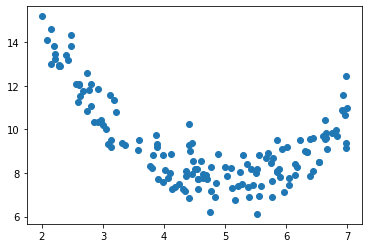2.4 - Loss functions in Tensorflow
Contents
2.4 - Loss functions in Tensorflow¶
!wget -nc --no-cache -O init.py -q https://raw.githubusercontent.com/rramosp/2021.deeplearning/main/content/init.py
import init; init.init(force_download=False);
import numpy as np
import matplotlib.pyplot as plt
import pandas as pd
import tensorflow as tf
%matplotlib inline
from tensorflow.keras import Sequential
from tensorflow.keras.layers import Dense, Input
from tensorflow.keras import Model
tf.__version__
'2.4.0'
A sample dataset¶
A very simple regression task, with one input and one output
d = pd.read_csv("local/data/trilotropicos.csv")
y = d.densidad_escamas.values.astype(np.float32)
X = np.r_[[d.longitud.values]].T.astype(np.float32)
X.shape, y.shape
((150, 1), (150,))
plt.scatter(X, y)
<matplotlib.collections.PathCollection at 0x7f12414d1640>

Linear regression with Tensorflow Sequential API¶
Observe how we implement a standard Linear Regression model with Tensorflow Sequential model.
def get_model_sequential(loss):
model = Sequential()
model.add(Dense(1, input_shape=(X.shape[-1],), activation="linear"))
model.compile(optimizer=tf.keras.optimizers.SGD(learning_rate=0.01), loss=loss)
return model
model = get_model_sequential(loss="mse")
model.fit(X,y, epochs=400, batch_size=16, verbose=0);
model.get_weights()
[array([[-0.7696493]], dtype=float32), array([12.655966], dtype=float32)]
and we can always call the trained model on any input data to make new predictions
model(np.r_[[[5],[6],[7]]]).numpy()
array([[8.807719 ],
[8.03807 ],
[7.2684207]], dtype=float32)
model.predict(np.r_[[[5],[6],[7]]])
array([[8.807719 ],
[8.03807 ],
[7.2684207]], dtype=float32)
the weights obtained are quite similar with the standard scikit-learn implementation
from sklearn.linear_model import LinearRegression
lr = LinearRegression()
lr.fit(X,y)
lr.coef_, lr.intercept_
(array([-0.71805906], dtype=float32), 12.689999)
note we are using the predefined Mean Squared Error loss function in Tensorflow
model = get_model_sequential(loss=tf.keras.losses.MSE)
model.fit(X,y, epochs=400, batch_size=16, verbose=0);
model.get_weights()
[array([[-0.72692335]], dtype=float32), array([12.650194], dtype=float32)]
model(np.r_[[[5],[6],[7]]]).numpy()
array([[9.015577],
[8.288654],
[7.561731]], dtype=float32)
We could have implemented ourselves. Recall we MUST USE Tensorflow operations.
def mse_loss(y_true, y_pred):
return tf.reduce_mean((y_true-y_pred)**2, axis=-1)
model = get_model_sequential(loss=mse_loss)
model.fit(X,y, epochs=400, batch_size=16, verbose=0);
model.get_weights()
[array([[-0.6994947]], dtype=float32), array([12.679553], dtype=float32)]
model(np.r_[[[5],[6],[7]]]).numpy()
array([[9.182079],
[8.482585],
[7.78309 ]], dtype=float32)
You can even explicitly call the functions and check how they work
y_true = np.random.random(size=5)
y_preds = np.random.random(size=y_true.shape)
y_true, y_preds
(array([0.9562911 , 0.07832308, 0.70414816, 0.91567686, 0.23363904]),
array([0.63817035, 0.97924217, 0.4115003 , 0.55839522, 0.13775806]))
# numpy MSE
np.mean((y_true-y_preds)**2)
0.22706842585597964
# tf.keras MSE
tf.keras.losses.MSE(y_true, y_preds)
<tf.Tensor: shape=(), dtype=float64, numpy=0.22706842585597964>
# our implementation
mse_loss(y_true, y_preds)
<tf.Tensor: shape=(), dtype=float64, numpy=0.22706842585597964>
Linear regression with Tensorflow Functional API¶
We can use the same mechanism with the Functional API
def get_model_functional_1(loss):
inputs = Input(shape=(X.shape[-1],), name="input")
outputs = Dense(1, activation='linear', name="output")(inputs)
model = Model([inputs], [outputs])
model.compile(optimizer=tf.keras.optimizers.SGD(learning_rate=0.01), loss=loss)
return model
model = get_model_functional_1(loss="mse")
model.fit(X,y, epochs=400, batch_size=16, verbose=0);
model.get_weights()
[array([[-0.7317973]], dtype=float32), array([12.652348], dtype=float32)]
model(np.r_[[[5],[6],[7]]]).numpy()
array([[8.993361 ],
[8.261564 ],
[7.5297666]], dtype=float32)
model = get_model_functional_1(loss=tf.keras.losses.MSE)
model.fit(X,y, epochs=400, batch_size=16, verbose=0);
model.get_weights()
[array([[-0.7890887]], dtype=float32), array([12.644999], dtype=float32)]
model(np.r_[[[5],[6],[7]]]).numpy()
array([[8.699554 ],
[7.910466 ],
[7.1213775]], dtype=float32)
model = get_model_functional_1(loss=mse_loss)
model.fit(X,y, epochs=400, batch_size=16, verbose=0);
model.get_weights()
[array([[-0.7223748]], dtype=float32), array([12.674201], dtype=float32)]
model(np.r_[[[5],[6],[7]]]).numpy()
array([[9.062326 ],
[8.339952 ],
[7.6175776]], dtype=float32)
However, when using the Functional API we have more flexibility. The following code is an orthodox way of defining a supervised model, but it will be useful when dealing with Autoencoders later on to use them in an unsupervised manner.
Observe the following aspects:
We DEFINE our model to have two inputs: \(X\) (on layer
inputs) and \(y\) (on layertargets).We DEFINE our model to have one output on layer
outputsjust like before. Observe that the new layertargetsdoes not participate in producing this output.We INTEGRATE the loss into the model by using directly the model layers and the
model.add_lossmethod.We DO NOT need to specify the
losswhen compiling the model.The
targetslayer only participates in computing thelossand, thus, it is only used during TRAINING, not on inference.
def get_model_functional_2():
inputs = Input(shape=(X.shape[-1],), name="inputs")
targets = Input(shape=(1,), name="targets")
outputs = Dense(1, activation='linear', name="outputs")(inputs)
model = Model([inputs, targets], [outputs])
loss = tf.reduce_mean((outputs-targets)**2)
model.add_loss(loss)
model.compile(optimizer=tf.keras.optimizers.SGD(learning_rate=0.01))
return model
observe how, due to this new architecture, the call to the .fit method now changes, although the results are the same.
model = get_model_functional_2()
model.fit([X,y], epochs=400, batch_size=16, verbose=0);
model.get_weights()
[array([[-0.7307422]], dtype=float32), array([12.66002], dtype=float32)]
HOWEVER when calling the model (inference) we MUST provide both \(X\) and \(y\), even if we know that \(y\) will not be used (it is only used when training). Observe how the following call always yields the same result regardless the values of \(y\).
This is INCONVENIENT for a supervised model, but illustrates the flexibility of the functional API.
X = np.r_[[[5],[6],[7]]]
y = np.random.random(size=(3,1))
print (y)
model([X, y]).numpy()
[[0.58962311]
[0.48533767]
[0.14276567]]
array([[9.006309 ],
[8.275566 ],
[7.5448246]], dtype=float32)

